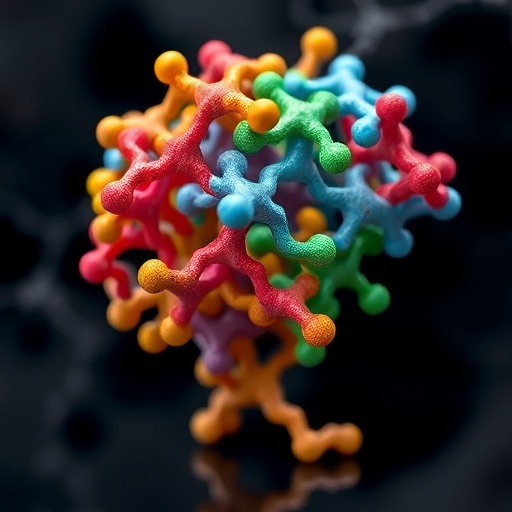In a groundbreaking study poised to reshape our understanding of protein structures, researchers from a prominent academic institution have delved deep into the intricate world of arginine/glycine-rich motifs (RG-rich motifs) as found within the human proteome. These motifs are not just decorative elements in proteins; they are fundamentally involved in myriad cellular processes such as RNA binding, chromatin remodeling, and forming the structural backbone of several functional ribonucleoprotein complexes. This ongoing exploration into the sequence context of these motifs may unlock new avenues for understanding diseases linked to protein misfolding and dysfunction.
The study, titled “Computational investigation of the sequence context of arginine/glycine-rich motifs in the human proteome,” presents a thorough computational analysis that enhances our molecular comprehension of how RG-rich motifs function. Through advanced bioinformatics techniques, the researchers meticulously mapped these motifs against a rich tapestry of protein sequences, revealing important associations that may have previously gone unnoticed. By employing multiple sequence alignments and structural predictions, they have offered fresh perspectives on how these motifs influence protein interactions and stability.
At the heart of this investigation lies a critical challenge in biological research: understanding the role of non-coding sequences in the human genome and their impact on the functionality of proteins. The research team employed sophisticated computational models designed to analyze not only the motifs themselves but also their sequence neighbors. They aimed to unravel the sophisticated coding patterns that determine how these motifs behave within different proteins and cellular contexts.
The results from this extensive computational research illuminate the delicate balance within protein structures. The masterful interplay between RG-rich motifs and their sequence contexts provides insights into protein folding dynamics, thus influencing cellular responses under various physiological conditions. This aspect is particularly critical when considering the implications for diseases that arise from dysfunctional protein interactions, including neurodegenerative disorders and various types of cancers which are often linked to misregulated protein motility and expression.
One of the primary methodologies utilized in this study involved high-throughput data mining from existing genomic databases. By aggregating data from various sources, the researchers were able to construct a comprehensive profile of RG-rich motifs basking amidst an ocean of human protein sequences. This computational approach not only expedites the identification of novel motifs but also reveals evolutionary patterns, serving as a time capsule of biological history hidden within the folds of proteins.
Moreover, the authors took advantage of machine learning techniques to enhance the predictive accuracy of their models. This integration of artificial intelligence tools signifies a paradigm shift in computational biology where predictive analytics can effectively anticipate motifs’ functional capabilities based on their contextual environments. The foresight offered by these advanced methodologies is pivotal for preemptively identifying potential therapeutic targets essential for drug development.
In viewing these motifs through an evolutionary lens, the study posits that RG-rich motifs have been conserved across many species, indicating their fundamental importance in biological systems. The researchers trace the evolutionary lineage, noting that understanding the conservation of these sequences can provide valuable insights into the mechanisms of protein evolution and the functionality underlying specific protein interactions. This has profound implications for evolutionary biology, as well as for therapeutic developments in disorders characterized by protein aggregation.
The study highlights several specific examples where RG-rich motifs have been implicated in key cellular mechanisms. For instance, these motifs are essential in forming complexes with RNA, influencing gene expression regulation. The implications of this are vast, as many biological processes are tightly regulated by RNA-binding proteins, which rely on these motifs to execute their functions. The paper discusses how aberrations in these motifs can lead to miscommunication within the cellular machinery, underscoring their importance.
In addition to their biological significance, the structural implications of RG-rich motifs are noteworthy. The researchers examined the three-dimensional conformations that these motifs can adopt, presenting a comprehensive view of protein folding. This structural insight is critical for understanding how proteins maintain their stability in the cellular milieu, and how they can sometimes fall prey to aggregation, a hallmark of many neurological diseases such as Alzheimer’s.
The findings reported by Schumbera and colleagues have spurred a wave of curiosity within the scientific community. The notion that these motifs play multifaceted roles prompts further inquiry into whether targeting these regions with small molecules could ameliorate diseases associated with protein aggregation. The paper lays the groundwork for future research endeavors that might yield novel therapeutic strategies aimed at modulating the functionality of RG-rich motifs.
As researchers continue to delve into the intricate world of the human proteome, this study serves as a timely reminder of the sophistication within biological systems. The computational investigations shed light on aspects of protein functionality that have long been overlooked, driving home the idea that the human genome harbors vast reservoirs of untapped knowledge waiting to be uncovered.
In conclusion, the detailed computational investigation into arginine/glycine-rich motifs signals a significant milestone in genomic research. The interactions of these motifs within their sequence context offer key insights into protein behavior and cellular processes that extend far beyond mere protein mechanics. This study is poised to illuminate new paths in bioscience, impacting various fields from molecular biology to therapeutic drug design. The journey into the depths of the human proteome is just beginning, and this work stands as a beacon guiding the way forward.
Subject of Research: Arginine/Glycine-rich motifs in human proteome.
Article Title: Computational investigation of the sequence context of arginine/glycine-rich motifs in the human proteome.
Article References:
Schumbera, E., Dormann, D., Walther, A. et al. Computational investigation of the sequence context of arginine/glycine-rich motifs in the human proteome. BMC Genomics 26, 883 (2025). https://doi.org/10.1186/s12864-025-12132-5
Image Credits: AI Generated
DOI: 10.1186/s12864-025-12132-5
Keywords: arginine/glycine-rich motifs, human proteome, protein structure, computational biology, disease mechanisms, RNA binding, protein interactions, bioinformatics.
Tags: arginine glycine-rich motifsbioinformatics techniques in biologycellular processes RNA bindingchromatin remodeling mechanismscomputational analysis protein motifshuman proteome protein structuresnon-coding sequences impactprotein interactions stabilityprotein misfolding diseasesribonucleoprotein complexes functionsequence context of motifsstructural predictions in proteins





